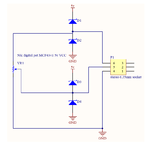brownt
Member level 3
Hi,
I am using a pair of schottky diodes to protect the input lines to a digital potentiometer.
The digital potentiometer is powered by the same 5volt line as the microcontroller that drives it via SPI, and the same 5volt line as the schottky diodes.
There is a small voltage at the anode/cathode junction about 50mV when I use BAT54S, and about 150mv when I use 1N5817.
I wonder why that is so, and how to stop it from happening.
thanks
I am using a pair of schottky diodes to protect the input lines to a digital potentiometer.
The digital potentiometer is powered by the same 5volt line as the microcontroller that drives it via SPI, and the same 5volt line as the schottky diodes.
There is a small voltage at the anode/cathode junction about 50mV when I use BAT54S, and about 150mv when I use 1N5817.
I wonder why that is so, and how to stop it from happening.
thanks
